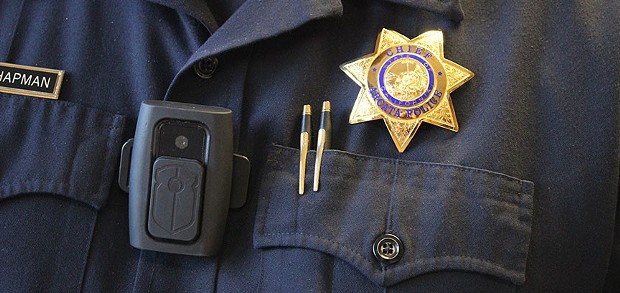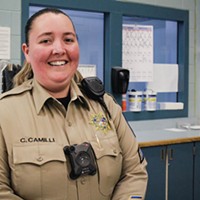[
{
"name": "Top Stories Video Pair",
"insertPoint": "7",
"component": "17087298",
"parentWrapperClass": "fdn-ads-inline-content-block",
"requiredCountToDisplay": "1"
}
]
It was with a great sense of disappointment that I sat down in the Wharfinger Building on Nov. 13 and watched Humboldt County District Attorney Maggie Fleming publicly unveil a draft policy covering every law enforcement agency in the county that will decide which police officer involved shooting videos will be publicly released and how.
Don't get me wrong: I think it's a very good thing that Fleming and the Law Enforcement Chiefs Association of Humboldt are looking to join just a handful of counties nationwide that have adopted a uniform policy dictating how these videos are handled and made public. And I'm extremely glad they have opted to gather public input on what's being proposed. And while I have some comments on the draft (more on that later), I don't think it's an unreasonable place to start the conversation, especially given that Fleming and the chiefs have rather proactively brought this forward.
No, my disappointment stemmed from the fact that I was one of just seven people lost in the sea of empty chairs at the meeting — a number that included three law enforcement officers and Sean McLaughlin of Access Humboldt, which was filming the meeting.
I can't help but think there would have been a much different turnout — and a much different meeting — had this draft proposal come on the heels of a controversial shooting, much less a string of them like we had a decade ago when Eureka police officers killed five suspects in a 15-month-span. But the thing is, this proposal being discussed right now will dictate what happens the next time someone is dead from a police officer's bullet amid a swarm of questions.
Following a national trend, police video technology is becoming more and more prevalent in Humboldt County. The Eureka Police Department has dash-mounted cameras in its patrol cars and body-worn cameras are part of officers' uniforms, as is the case in Rio Dell and Ferndale. The Arcata Police Department has dash cameras and is expected to roll out body cameras in the coming months. The sheriff's office, meanwhile, has been looking into body cameras but is leery of making the plunge of outfitting the county's largest force, which would come with a hefty price tag and a host of time commitments.
But the fact is most law enforcement agencies in Humboldt County have some type of video technology that they use to document interactions with citizens, arrests and — when things go sideways — shootings. While most of them were rolled out under a banner of transparency, the fact remains that the vast majority of this footage never sees the light of day. So having a policy under which the default assumption is that videos of police shootings will be released is in and of itself a big deal.
And Fleming made clear in her presentation that she and local chiefs view this draft policy as a first step, starting with the most critical incidents police are involved in. If this proves manageable, they might next look at a policy governing the release of video for all incidents in which someone's life is lost, then one that covers videos depicting the use of force.
Based on a landmark policy drafted in San Diego, the protocol being pushed by Fleming and the chiefs is inherently a compromise, an effort to balance the often competing interests that abound when discussing whether to make public a video of someone's death.
Under the protocol, release of these videos would be wrapped into the district attorney's review of these incidents to determine if any of the officers involved acted criminally. In cases where the officers are cleared, the default would be that the video would be released. If the district attorney pursues charges, the video would be presented as part of the ensuing criminal proceedings. So the assumption is that, either way, the videos would become part of the public record of the shooting.
But the policy leaves some wiggle room. It allows for a police department to unilaterally release a video before the district attorney's review is complete if it's in the interest of public safety, for instance, if protesters are rioting in the streets. And it allows the district attorney to ultimately withhold the video if it's in the interest "of justice, public safety or human decency." It also states that the district attorney's office will release a statement accompanying the video to "provide context," that it will only release the segment of the video relevant to its legal analysis and that it will blur out the faces of the officers, witnesses and the person or people shot.
Presenting the protocol, Fleming said it's an effort to compromise the interests of grieving families, the public's need for transparency, sometimes traumatized officers and her office's need to protect the integrity of investigations and prosecutions.
Personally, I think it goes too far. I would argue that, because investigations and reviews of officer-involved shootings often span close to a year, the videos could be released earlier in the process — after eye witnesses are interviewed — without jeopardizing investigations. And I think that blurring out the faces of officers and those shot is generally unwarranted as there is no expectation of privacy in public spaces or for public officials carrying out their public duties. I would also argue that blurring out the faces involved in these interactions dehumanizes them, makes them less tangible and gets in the way of the community understanding of these incidents that is necessary to facilitate productive conversations about police use of force.
But I'm not naïve. I realize there are no clear answers here. Full, prompt transparency may complicate some investigations and make it a bit more difficult to find an unbiased jury, while also subjecting families and officers to having some of the worst moments of their lives on public display. On the other hand, delayed, partial transparency may not really give the public the tools it needs — the understanding of the complexities of these incidents and what leads to them — necessary to properly evaluate the public officials it entrusts with guns and the responsibility of protecting us.
I have my opinions about what a perfect policy should look like — and I'll probably share them with you in the near future. But I believe the more important thing at this moment is that you think about what your perfect policy would be — or which of the competing interests you think are most important to protect — and you weigh in. Fleming is holding another meeting Nov. 16 at 6 p.m. in the Veteran's Hall in Willow Creek to get additional input on the protocol, which you can find in the digital version of this editorial at www.northcoastjournal.com. She's also accepting emails to [email protected] (just put "OIS" in the subject line).
With this protocol, Humboldt County has the chance to be at the forefront of one of the most critically important issues of our time. I believe our local police chiefs and Fleming are doing their best to come up with a good faith compromise. But I also believe a group of cops and a prosecutor likely can't adequately weigh all of the interests involved here on behalf of we citizens of Humboldt County. They need our input to get this right.
Thadeus Greenson is the Journal's news editor. Reach him at 442-1400, extension 321, or [email protected]. Follow him on Twitter @thadeusgreenson.
Comments
Showing 1-1 of 1
more from the author
-
Deputy Shoots Cutten Shooting Suspect
- Apr 25, 2024
-
Officials Weigh in on SCOTUS Case's Local Implications
- Apr 25, 2024
-
Arcata Lowers Earth Flag as Initiative Proponents Promise Appeal
- Apr 25, 2024
- More »

































